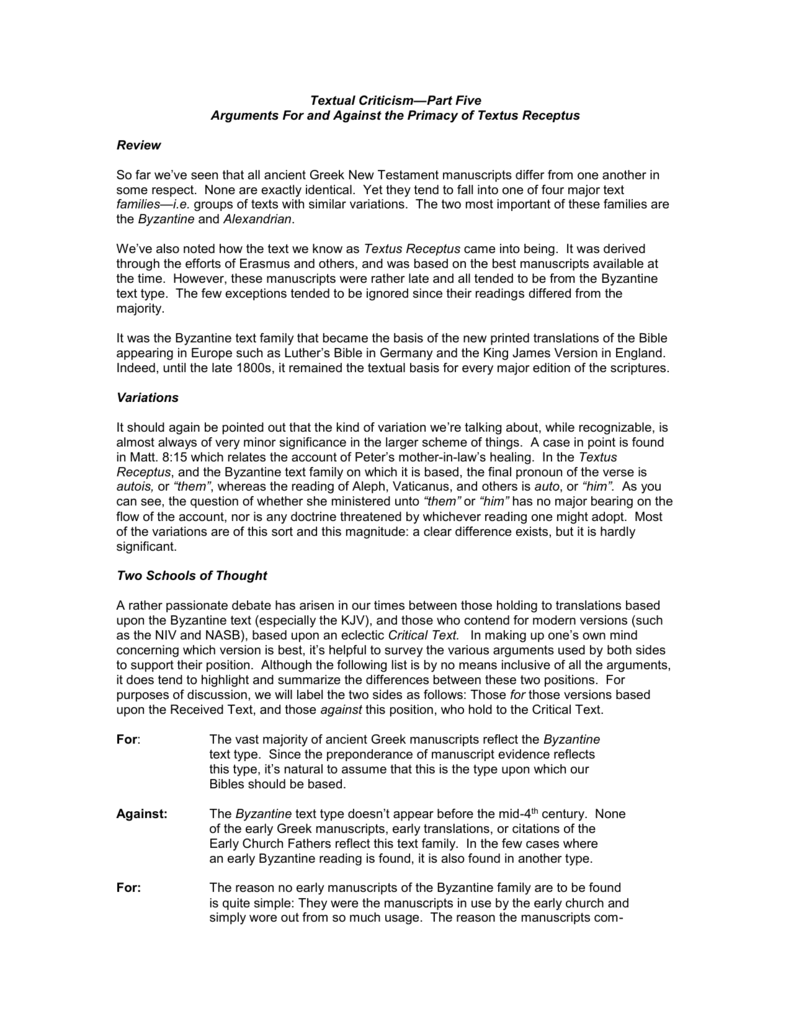Textus Receptus Vs Critical Text


The 1990 Preface sketches the textual critical scene as follows: The King James New Testament was based on the traditional text of the Greek-speaking churches, first published in 1516, and later called the Textus Receptus or Received Text. It has been customary in England to employ the 1550 text of Stephanus as the exemplar of the textus receptus (just as an Elzevir text was so adopted on the continent of Europe), and so we will follow this custom. For our purposes here, the term textus receptus means the 1550 edition of the Greek New Testament published by Robertus Stephanus.
Textus ReceptusThe Textus Receptus is thetext that has been used for 2,000 years by Christians. This is also thetext that agrees with more than 95% of the Bible Manuscripts in Koine(common)Greek. Itis known by other names, such as the Traditional Text,Majority Text, Byzantine Text, or Syrian Text.In his essay TexualCriticism, Dr. Thomas Cassidy writes: ' The Traditional text of the New Testament has existed from the timeof Christ right down to the present. It has had many different namesdown through the years, such as Byzantine Text, Eastern Text, ReceivedText, Textus Receptus, Majority Text, and others.
Although no completeBible manuscripts have survived which would allow us to date theTraditional text to the first century, there is a strong witness to theearly existence and use of the Traditional text by the early church inits lectionaries.' A few facts showing the respected historical position of the TextusReceptus are in order. Its prominence and respect did not begin in 1611with the KJV translators.
In fact, the folder ensures that if Firefox ever crashes or disappears, information that is valuable to you and your business will be preserved. Where are firefox favorites.
They merely recognized (as others before themhad), that the Textus Receptus was God's preserved word in the originalNew Testament language.Consider the following:.Prior to the 20thcentury, all English Bibles since Tyndale's firstNew Testament (1526) were based on the Textus Receptus. Thisincludes: Miles Coverdale's Bible (1535), Matthew's Bible(1500-1555), The Great Bible (1539), The Geneva Version (1560), TheBishops' Bible (1568), and the King James Version (1611).
STORY OF OUR ENGLISH BIBLE, by W. Scott.AncientVersions followed the reading of the Textus Receptus. Theseversions include: The Peshitta Version (AD 150), The Italic Bible(AD 157), The Waldensian (AD 120 & onwards), The Gallic Bible(Southern France) (AD177), The Gothic Bible (AD 330-350), The OldSyriac Bible (AD 400), The Armenian Bible (AD 400 There are 1244copies of this version still in existence.), The Palestinian Syriac(AD 450), The French Bible of Oliveton (AD 1535), The Czech Bible(AD 1602), The Italian Bible of Diodati (AD 1606), The GreekOrthodox Bible (Used from Apostolic times to the present day by theGreek Orthodox Church).
Bible Versions, D.B.LoughranIn his excellent book,Truth Triumphant: The Church in the Wilderness, Benjamin Wilkinsonwrites, ' The Protestant denominations are built upon that manuscriptof the Greek New Testament sometimes calledTextus Receptus, or the Received Text. It is thatGreek New Testament from which the writings of the apostles in Greek have been translated into English,German, Dutch and other languages. During the dark ages theReceived Text was practically unknown outside the GreekChurch. It was restored to Christendom by the labours of thatgreat scholar Erasmus. It is altogether too little known thatthe real editor of the Received Text was Lucian. None ofLucian's enemies fails to credit him with this work. NeitherLucian nor Erasmus, but rather the apostles, wrote the Greek NewTestament.
However, Lucian's day was an age of apostasy when aflood of depravations was systematically attempting to devastateboth the Bible manuscripts and Bible theology., ofthe Alexandrian college, made his editions and commentaries ofthe Bible a secure retreat for all errors, and deformed themwith philosophical speculations introducing casuistry and lying.Lucian's unrivalled success in verifying, safeguarding,and transmitting those divine writings left a heritage for whichall generations should be thankful.' Why did the early churches of the 2 nd and 3 rdcenturies and all the Protestant Reformers of the15 th, 16 thand 17 th centuries choose Textus Receptus in preference to the Minority Texts?The answer is becauseof the following:.Textus Receptus is based on the vast majority (over 95%) ofthe 5,300+ Greek manuscripts in existence. That is why it is alsocalled the Majority Text.Textus Receptus is not mutilated with deletions,additions and amendments, as is the Minority Text.Textus Receptus agrees with the earliest versions of theBible: Peshitta (AD150) Old Latin Vulgate (AD157), theItalic Bible (AD157) etc.
Textual Choices and Bible VersionsTextual Choices and Bible VersionsBy Reese Currie, Compass DistributorsThis is one of two follow-up articles from the “Comparing Bible Versions” article. In thatarticle, I promised to share my views on textual choices (consensus text versus majority text) andtranslation technique (formal equivalency versus dynamic equivalency).
Textus Receptus Vs Critical Text
I will discuss dynamicequivalency next month. This month we will deal with textual issues.Which textual base is the best, the one based on the majority of manuscripts or the one based onthe scientific determinations of Bible scholars, the consensus text?The key to the answer is trust.
Which stream of documents can you trust the most? Thisquestion can only be answered by examining the historical facts of how both text streams camedown to us today, and determining from that which is more likely to represent the original textGod delivered through the apostles.How Serious Is This Issue?The truth of the matter is, both the critical text and the majority text are close enough to theoriginals and to one another that God can work through either text to bring people to salvation.There is at worst a 5% difference between the consensus text and the majority text. One mayask, “Then why address the topic at all?”I have struggled with this question.